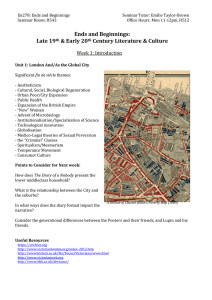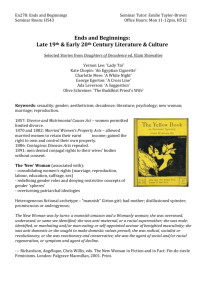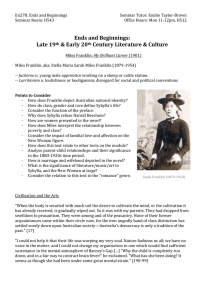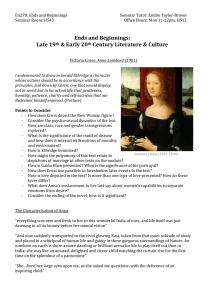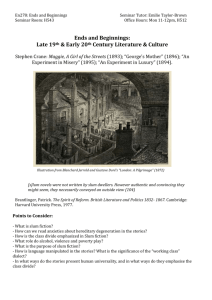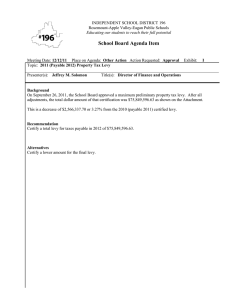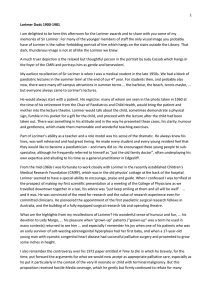En278: Ends and Beginnings Seminar Tutor: Emilie Taylor-Brown Seminar Room: H543
advertisement
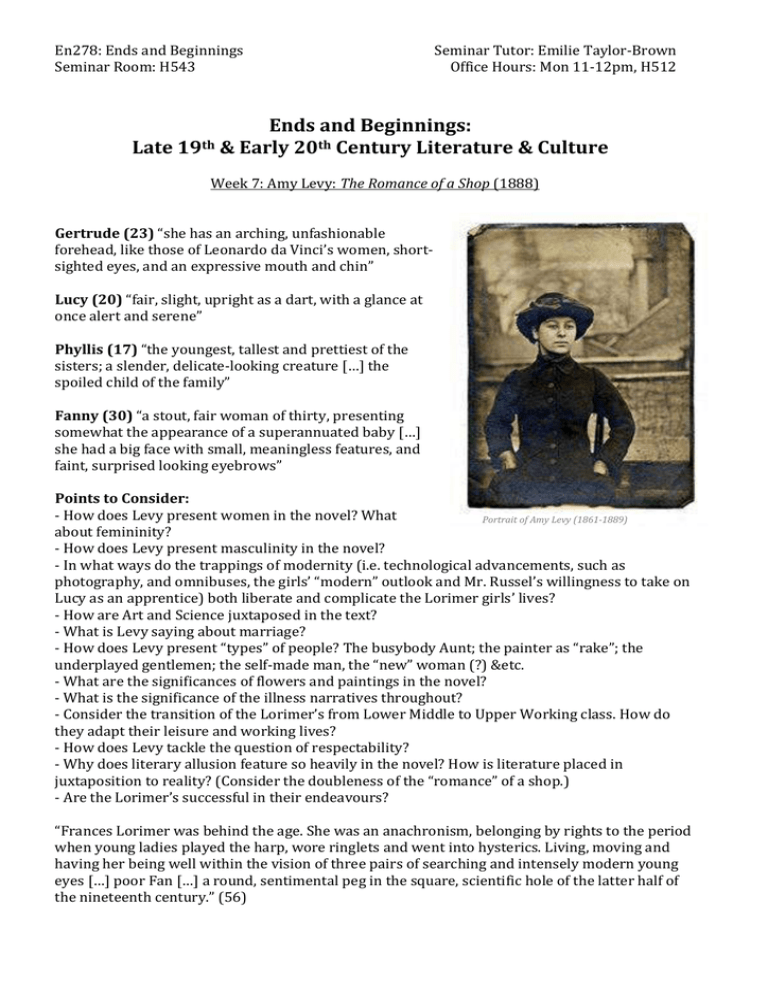
En278: Ends and Beginnings Seminar Room: H543 Seminar Tutor: Emilie Taylor-Brown Office Hours: Mon 11-12pm, H512 Ends and Beginnings: Late 19th & Early 20th Century Literature & Culture Week 7: Amy Levy: The Romance of a Shop (1888) Gertrude (23) “she has an arching, unfashionable forehead, like those of Leonardo da Vinci’s women, shortsighted eyes, and an expressive mouth and chin” Lucy (20) “fair, slight, upright as a dart, with a glance at once alert and serene” Phyllis (17) “the youngest, tallest and prettiest of the sisters; a slender, delicate-looking creature […] the spoiled child of the family” Fanny (30) “a stout, fair woman of thirty, presenting somewhat the appearance of a superannuated baby […] she had a big face with small, meaningless features, and faint, surprised looking eyebrows” Points to Consider: - How does Levy present women in the novel? What Portrait of Amy Levy (1861-1889) about femininity? - How does Levy present masculinity in the novel? - In what ways do the trappings of modernity (i.e. technological advancements, such as photography, and omnibuses, the girls’ “modern” outlook and Mr. Russel’s willingness to take on Lucy as an apprentice) both liberate and complicate the Lorimer girls’ lives? - How are Art and Science juxtaposed in the text? - What is Levy saying about marriage? - How does Levy present “types” of people? The busybody Aunt; the painter as “rake”; the underplayed gentlemen; the self-made man, the “new” woman (?) &etc. - What are the significances of flowers and paintings in the novel? - What is the significance of the illness narratives throughout? - Consider the transition of the Lorimer’s from Lower Middle to Upper Working class. How do they adapt their leisure and working lives? - How does Levy tackle the question of respectability? - Why does literary allusion feature so heavily in the novel? How is literature placed in juxtaposition to reality? (Consider the doubleness of the “romance” of a shop.) - Are the Lorimer’s successful in their endeavours? “Frances Lorimer was behind the age. She was an anachronism, belonging by rights to the period when young ladies played the harp, wore ringlets and went into hysterics. Living, moving and having her being well within the vision of three pairs of searching and intensely modern young eyes […] poor Fan […] a round, sentimental peg in the square, scientific hole of the latter half of the nineteenth century.” (56) En278: Ends and Beginnings Seminar Room: H543 Seminar Tutor: Emilie Taylor-Brown Office Hours: Mon 11-12pm, H512 Class Mobility and Respectability “Is it necessary to give up the habits of ladies because you are poor?” (100) “Aunt, how shall I say it for you to understand? We have taken life from a different standpoint, begun it on different bases. We are poor people, and we are learning to find out the pleasures of the poor, to approach happiness from another side. We have none of the conventional social opportunities for instance, but are we therefore to sacrifice all social enjoyment? You say we ‘follow Mr. Jermyn to his studio;’ we have our living to earn, no less than our lives to live, and in neither case can we afford to be the slaves of custom. Our friends must trust us or leave us; we must rely on our self-respect and our judgment. Convention apart, are not judgment and selfrespect what we most of us do rely on in our relations with people, under any circumstances whatsoever?” (101) “Don’t you know it is quite distinguished to keep a shop? That poets sell wall-papers, and firstclass honours men sell lamps? That Girton students make bonnets, and are thought none the worse for doing so?” (54-55) “Aunt Caroline, shifting her ground, ceased to talk of the scheme as beneath contempt, but denounced it as dangerous and unwomanly. She spoke freely of loss of caste; damage to prospects […] and of the complicated evils which must necessarily arise form an undertaking so completely devoid of chaperones.” (72) Illness and fragility “Phyllis was too delicate for such expeditions, and sat at home with Mrs. Devonshire, or drove out shopping […] the charming child that everybody conspired to spoil, that everybody instinctively screened from all unpleasantness.” (73) “Phyllis, you are coughing terribly. Do come away from that draughty place” cried Gertrude with real anxiety. (105) “…no one had taken any notice of the young woman by the doorway, with her pale face and suit of rusty black. “I feel like a ghost,” she [Gertrude] said to Frank, as she handed him her empty cup. “You do look horribly white,” he answered with genuine concern.” (113) “Come upstairs with me [Fan] and lie down. You have not been looking well all week.” (124) “Constance Devonshire had dropped in upon them unexpectedly that afternoon, after an absence of several weeks. She was looking wretchedly ill. Her usually blooming complexion had changed to a curious waxen colour; her round face had fallen away; there were dark hollows under the unnaturally brilliant eyes.” (128) “Phyllis, indeed, had not been very well of late, and demanded more spoiling than ever. She coughed constantly, and her eyes were unnaturally bright.” (149) En278: Ends and Beginnings Seminar Room: H543 Seminar Tutor: Emilie Taylor-Brown Office Hours: Mon 11-12pm, H512 Literature and Writing “My dear Gertrude, what’s this? Rachel weeping among her children?” […] Her quick, blue eyes fell on the basket with its overflowing papers. “Gerty, what is the meaning of this massacre of the innocents?” (60) “The verses were signed “G. Lorimer:; and Gertrude’s eyes rested on them with the peculiar tenderness with which we all of us regard our efforts the first time that we see ourselves in print […she] rose and folded the seductive Woodcut, with a get-thee-behind-me-Satan air.” (121-22) “People always come back in books,” Fanny had said, endeavouring, in all good faith, to administer consolation; and Lucy had actually laughed. (163) “Gertrude wonders if he will prove to have inherited his father’s scientific tastes, or the literary tendencies of his mother. She devoutly hopes that it is the former.” (193) Photography: Art or Science? It is now more than fifteen years ago that specimens of a new and mysterious art were first exhibited to our wondering gaze […] Since then photography has become a household word and a household want; is used alike by art and science, by love, business, and justice [….] for everything which Art, so called, had hitherto been the means but not the end, photography is the allotted agent – for all that requires mere manual correctness and mere manual slavery, without any employment of the artistic feeling, she is the proper and therefore the perfect medium. She is made for the present age, in which the desire for art resides in a small minority, but the craving, or rather necessity, for cheap, prompt, and correct facts lies in the public at large. […] What are her representations […] but facts which are neither the province of art nor of description, but of that new form of communication between man and man—neither letter, message, nor picture—which now happily fills up the space between them? Miss Levy really must not fold her heroine to her lover’s breast at the end “like a tired child.” She might as well make the lover himself “pass his hand over his fevered brow. ---From George Saintsbury, “New Novels” The Academy (10 Nov 1888): 301-3. No doubt there are symptoms of portraiture throughout the story: but this only makes whatever success it has the more conspicuous, seeing that nothing is so difficult, in the whole art of fiction, as actual portraiture: nothing –paradoxical as the assertion may seem— is so almost certain to give an air of unreality. --- From H. C. Brewer, “New Novels” The Graphic (24 Nov 1888): 558. En278: Ends and Beginnings Seminar Room: H543 Seminar Tutor: Emilie Taylor-Brown Office Hours: Mon 11-12pm, H512 Gerard Genette and Transtextuality Intertextuality – a text segment present in another text: quoting, plagiarism, allusion. Paratextuality – two texts linked together by paratexts (titles, dedications, footnotes, chapter titles, etc) Hypertextuality – any relationship uniting text B (the hypertext) to an earlier text (the hypotext), upon which it is grafted in a manner that is not that of commentary, but which it transforms, modifies, elaborates or extends. E.g. parody, spoof, translation, sequel. Architextuality – a genre classification that is dependent on the expectations of the reader The Simulacrum A representation or imitation of a person or thing. An image without the substance or qualities of the original. A copy without an original; a representation, a sign, without an original referent. (the hyperreal) Jean Baudrillard recognises three "orders of simulacra": 1) in the first order of simulacra, which he associates with the pre-modern period, the image is a clear counterfeit of the real; the image is recognized as just an illusion, a place marker for the real; 2) in the second order of simulacra, which Baudrillard associates with the industrial revolution of the nineteenth century, the distinctions between the image and the representation begin to break down because of mass production and the proliferation of copies. Such production misrepresents and masks an underlying reality by imitating it so well, thus threatening to replace it (e.g. in photography or ideology); however, there is still a belief that, through critique or effective political action, one can still access the hidden fact of the real; 3) in the third order of simulacra, which is associated with the postmodern age, we are confronted with a precession of simulacra; that is, the representation precedes and determines the real. There is no longer any distinction between reality and its representation; there is only the simulacrum.
